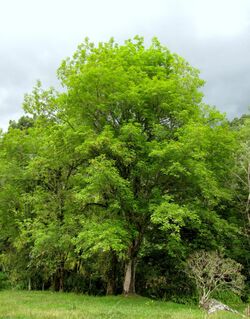Biology:Fraxinus uhdei
| Fraxinus uhdei | |
|---|---|

| |
| Scientific classification | |
| Kingdom: | Plantae |
| Clade: | Tracheophytes |
| Clade: | Angiosperms |
| Clade: | Eudicots |
| Clade: | Asterids |
| Order: | Lamiales |
| Family: | Oleaceae |
| Genus: | Fraxinus |
| Section: | Fraxinus sect. Melioides |
| Species: | F. uhdei
|
| Binomial name | |
| Fraxinus uhdei | |
| Synonyms[2] | |
| |
Fraxinus uhdei, commonly known as tropical ash or Shamel ash, is a species of tree native to Mexico and Central America.[3] It is commonly planted as a street tree in Mexico and the southwestern United States. It has also been planted and spread from cultivation in Hawaii, where it is now considered an invasive species.[3]
Like other species in the section Melioides, Fraxinus uhdei is dioecious, with male and female flowers produced on separate individuals.[4]
Taxonomy
The tropical ash was originally described as a variety of Fraxinus americana (white ash) by Theodor Wenzig in 1883[5] and was separated as a different species in 1907 by Alexander von Lingelsheim.[6] The specific epithet uhdei refers to Carl Uhde, a German plant collector who explored Mexico in the 1840s.[7]
Fraxinus uhdei is locally known as fresno blanco in Spanish; other English vernacular names include Hawaiian ash and Mexican ash.[3] The name Shamel ash refers to Archie Shamel, who introduced the trees to California in the 1920s.[7] It is known as Urapan in Colombia, where it was introduced in the 1950s.[8]
Ecology
A dieback caused by a phytoplasma was recorded in Colombia and Ecuador in 2004.[8]
References
- ↑ Westwood, M.; Samain, M.; Martínez Salas, E. (2017). "Fraxinus uhdei". IUCN Red List of Threatened Species 2017: e.T96444707A96444709. doi:10.2305/IUCN.UK.2017-3.RLTS.T96444707A96444709.en. https://www.iucnredlist.org/species/96444707/96444709. Retrieved 11 January 2023.
- ↑ "Fraxinus uhdei (Wenz.) Lingelsh.". Royal Botanic Gardens, Kew. https://powo.science.kew.org/taxon/urn:lsid:ipni.org:names:105922-2.
- ↑ 3.0 3.1 3.2 Pasiecznik, Nick (2016). "Fraxinus uhdei" (in en). Centre for Agriculture and Bioscience International (CABI). https://www.cabi.org/isc/datasheet/24559.
- ↑ Wallander, Eva (2008). "Systematics of Fraxinus (Oleaceae) and evolution of dioecy". Plant Systematics and Evolution 273 (1–2): 25–49. doi:10.1007/s00606-008-0005-3.
- ↑ "Fraxinus americana var. uhdei Wenz.". Royal Botanic Gardens, Kew, Harvard University Herbaria & Libraries, and Australian National Botanic Gardens. http://ipni.org/n/105796-2.
- ↑ "Fraxinus uhdei Lingelsh.". Royal Botanic Gardens, Kew, Harvard University Herbaria & Libraries, and Australian National Botanic Gardens. http://ipni.org/n/105922-2.
- ↑ 7.0 7.1 Bracewell R.N. 2005. Trees of Stanford and environs. Stanford, CA, USA: Stanford Historical Society
- ↑ 8.0 8.1 Filgueira, J. J.; Franco-Lara, L.; Salcedo, J. E.; Gaitan, S. L.; Boa, E. R. (2004). "Urapan (Fraxinus udhei) dieback, a new disease associated with a phytoplasma in Colombia.". Plant Pathology 53 (4): 520. doi:10.1111/j.1365-3059.2004.01030.x.
Wikidata ☰ Q970638 entry
 |


